#Nikon Camera Systems
Explore tagged Tumblr posts
Text
It only took 9 years .... American Dipper (Cinclus mexicanus)
At last after a 9 year wait!
The first time I saw an American Dipper was in November 2014. I was on a Bald Eagle workshop with Moose Peterson in Haines, Alaska. It was a very dull and dark day and I saw this tiny (compared to Bald Eagles) quickly working along the river bank. I asked what it was and Moose said an American Dipper. Of course the light was so poor I couldn’t get a good image. Unfortunately, I did not see it…

View On WordPress
#NikkorZ100400VRS#NikonLove#nikonnofilter#NikonZ9#ZCreators#(Cinclus mexicanus)#@Service.Photo#american dipper#Birding#Jemez Springs#New Mexico#Nikkor Z 100-400mm f/4.5-5.6 VR S#Nikkor Z TC-1.4*#Nikon Camera Systems#Nikon Z 9#Richard King Photography#wildlife photography#www.mothernatureimages.com#www.richardkingphoto.com
2 notes
·
View notes
Text
No, OM System Isn't the Only Brand That Can Stand Up to Wet Weather
Late last year, we announced new changes to our reviews system. This is on top of all the other testing that we’ve done for years and called on the industry for. As it is, we’re constantly revamping our system of camera reviews. Today, we’re beginning the start of calling out what we believe to be falsehoods in the photography world. And this one has to do with a false statement about wet…
#Canon EF to Sony E mount Metabones adapter#digital camera world#insurance#ip durability#ip52#ip53#ip54#leica#lenses#LensRentals#nikon#OM SYSTEM#panasonic#sigma#sony#tamron#weather resistance
0 notes
Text

She's here, she's here, she's here! Welcome home, Yona!
I am so, so proud of her. The most complex custom I've ever done, and the one where the most things went wrong, too!
I widened the faceplate, which meant I had to change the entire head to accommodate. Part of her head broke and I had to repair it. Then one of her legs became permanently fused to a joint peg. That's no good because the pegs are soft and prone to breaking - they must be replaceable! I had to start the legs over from the beginning. The sealant was perfectly fine with all the paint except once - it made her face paint buckle! I had to sand it smooth, then repaint and keep going...
AND THE PAINT. omg. I went through multiple brands and types of acrylic paint, and all of them were complete failures. In desperation I turned for the first time to lacquer paint. That's WAY more heavy duty stuff than I ever planned to get into! But the results... oh, they speak for themselves. 🥰
FUN PHOTOGRAPHY THING. In the game, in sunlight, Yona is like. Lizard green. Bright, brilliant lime. But in rain or cloudy weather (and when you print her out in CYMK), she's a soft, cool, mint color.
I use a Nikon camera that boosts the eff out of yellow. So much that just about every photo I take, I have to go in and manually decrease the saturation on all yellow. I thought to myself, "If I paint Yona that brilliant shade of green, it's going to be a nightmare to edit. I'll just go with her rainy-weather color instead." But look at that photo! It's perfectly her shade! The camera looked at cool mint and made it anole green! 😁🎉
I feel like I understand the game's lighting system a little bit better now.
...why is her head decoration missing, you ask? (Well pretend you did.) It was too bulky to fit on the part of her head that I squished down to fit Nendoroid proportions. Also it would have been very fragile. And it would have made her taller than Sidon.
And once again addressing the great big obvious: what does this mean for my photography?
I... think I'm correct in guessing my reputation in this fandom is "the sidlink toy photographer", right?
I ship all three as a polycule. But the same way I take photos of Sidon and Link, Zelda and Link, all three together, or singles; there will be photos with Yona in and out of the mix.
Whatever ship you like, interpret it and indulge freely. Zelink, sidlink, sidona, sidlinkona, and any combination I haven't named. Or no ship at all, if you like everyone as friends. Tags, comments, spinoff interpretations - all is okay. Enjoy it to the fullest. Tbh, you can even slide a wish list my way. As long as I have the props and the time, I'm always happy taking photos!
I don't mind what you ship - see what makes you happiest. 😉
119 notes
·
View notes
Text

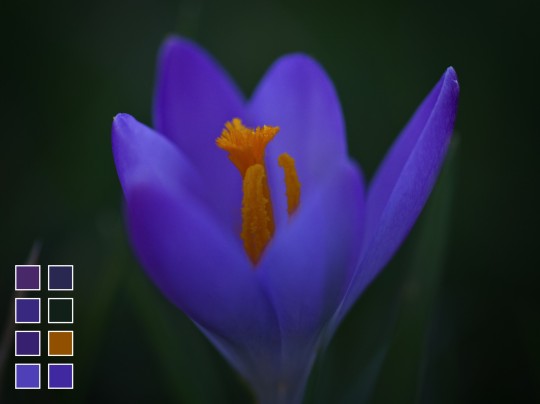


Colours of nature 🩶
As I'm leaving the Nikon eco system (no hate - great cameras, but I have too mount systems) so I adapted my sigma 70mm macro to my Olympus EM5 yesterday. Beautiful results
#photography#nature#photographers on tumblr#artists on tumblr#naturecore#macro perfection#wild flowers#flower core#flowercore#flowers#nature blog#natureshots#nature colors#colors
26 notes
·
View notes
Text
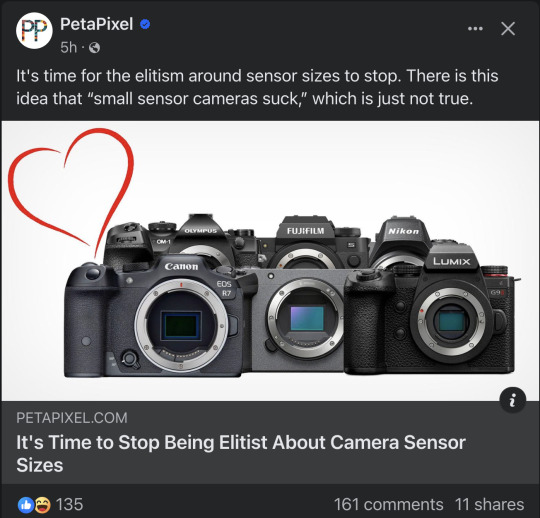
This article gets rewritten about every 3 months by someone who thinks they are writing it for the first time.
Also, no chance I am going into that comment section.
I'll make it very simple. Pretty much all cameras are great now. Most smartphone cameras are great.
So you can get great photos with *any* sensor size.
You just have to assess your needs and decide which system will help you achieve your photographic goals.
Full frame sensors make it much easier to...
Shoot in cramped spaces. Get background blur. Shoot a scene with bright brights and dark darks. (dynamic range) Shoot in low light with less noise.
APS-C sensors...
Slightly harder to get background blur. Not as good in cramped spaces. Slightly less dynamic range. Slightly more noise in low light. Give you near full frame quality at a lower price point.
Micro 4/3 sensors...
Give you lightweight and portable gear while maintaining the advantage of using different lenses. Can be more expensive. Great for beginner videography. Can do decent background blur with a speedbooster and fast lens. Give you a nice bump in quality over smartphones in challenging circumstances.
Smartphone sensors...
Are always in your pocket.
If you have the money and want to make getting good photos in challenging circumstances easier, get a full frame. Used full frame DSLRs are cheaper than they have ever been.
If you are on a tight budget and want everything a full frame does but don't mind it being about 1.5x harder to do so, get APS-C. If you go with Canon or Nikon, you can choose your lenses in a way that allows you to upgrade to full frame later on.
If you want to use a proper camera with interchangeable lenses but you don't feel like carrying a heavy camera bag with you everywhere, get a micro 4/3. Be warned, these cameras are usually more expensive than APS-C. They often have cool retro styling and try to give you a more fun photography experience. Panasonic M4/3 can be a great entry level videography camera. Fuji has some neat retro film emulation. Speedbooster accessories can allow you to retain some reasonable background blur.
For everything else, just use your phone because phones are great at everything except indoor low light situations.
87 notes
·
View notes
Note
Hello io! Happy holidays : ) ! I love your art and photography, I just wanted to know how do you take pictures? I’ve been looking into getting into photography myself as I don’t have much time to draw due to university.. Any camera recommendations? I really like the strange but also mellow ambiance in your photos.
hi anon! happy holidays! i hope you're having a nice, calm season, and that your health has been okay :-) thank you for the nice message!
it's funny, for me photography is even more of a casual hobby than drawing is, but i get so giddy whenever people like my photos, it's even greater of a compliment :D are you thinking about film or digital?
for film, i use an Olympus OM-2n with a vivitar series 1 28-90mm f2.8-3.5 lens, but that just happens to be the camera body and lens that i was able to pry out of a relative's closet. before that, i used a point-and-shoot, yashica t4 super... i am quite fond of the olympus om-2n as a camera body because it has a nice level of automation; it has an automatic exposure system that calculates a shutter speed based on aperture. it seems like all of the om system cameras have held up well and have a reputation for good quality
for digital, i use a nikon d3400 with the nikkor 50mm 1.8g lens- again, just an entry-level hobbyist dslr, it's never let me down.
i don't know if i can call myself knowledgeable enough to refer to these as recommendations! for film, it's worth asking family and looking around stores in your area that sell used goods... without falling into the trap of buying a "bargain" that'll cost ten times as much to fix
would much appreciate the advice of people who know more about this than i hehe
take care!
24 notes
·
View notes
Text
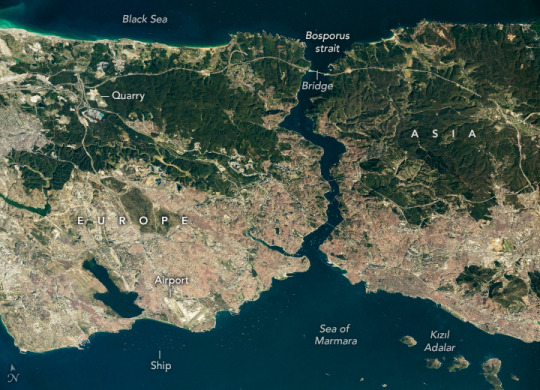
Istanbul: A Turkish Delight
An astronaut aboard the International Space Station took this photograph of Istanbul, Türkiye, while orbiting over the Black Sea. The Istanbul metropolitan area is the grayish region stretching across the lower part of the photo. The light pink tones come from the roofs of many of its buildings. The urban area contrasts with the dark-green hues of forested hills to the north.
The Istanbul metropolitan area, home to more than 16 million people, is a historical hub for commerce due to its unique geographical location. The city straddles the Bosporus strait, which serves as a direct link between the Black Sea to the north and the Sea of Marmara to the south. Many ships are visible as small specks in the various water bodies in the image.
The Bosporus not only divides Istanbul but also separates Europe and Asia, meaning the city spans two continents. The continents are linked by three bridges across the strait: one near the northern coast and two within the city. These bridges are all parts of major highway systems in the area. At the lower left of the image is the Atatürk Airport, which was once Istanbul’s main international airport. The new Istanbul International Airport is near the upper left of this image, just out of view.
On the European side of the strait, quarries appear as patches of dark gray and tan-colored land. The region is famous for its white marble, which has been used in the construction of many historical buildings across the city.
Along the southern coast, the urban fabric is broken up by small patches of vegetated land. The coastal region has a large concentration of parks, allowing residents to leave the bustle of the city and take in the coastal views. On the right side of the image, an archipelago known as Kızıl Adalar (also called Princes Islands) in the Sea of Marmara is a hotspot for tourism.
Astronaut photograph ISS072-E-34369 was acquired on October 8, 2024, with a Nikon Z9 digital camera using a focal length of 400 millimeters. It is provided by the ISS Crew Earth Observations Facility and the Earth Science and Remote Sensing Unit, Johnson Space Center. The image was taken by a member of the Expedition 72 crew. The image has been cropped and enhanced to improve contrast, and lens artifacts have been removed. The International Space Station Program supports the laboratory as part of the ISS National Lab to help astronauts take pictures of Earth that will be of the greatest value to scientists and the public, and to make those images freely available on the Internet. Additional images taken by astronauts and cosmonauts can be viewed at the NASA/JSC Gateway to Astronaut Photography of Earth. Caption by Chloe Locke, Amentum JETS II Contract at NASA-JSC.
5 notes
·
View notes
Text
Hi I like cameras and identifying them. Info under cut
This blog is run by exactly 1 person, you can call me Admin or Neil, I don't really mind either way. I like Nikon cameras the most because they're similar to my name
I'm part of a system so I will not always be around to identify stuff. Sorry! Follow our main blog @qcharlie
I will identify the camera make, model, and attachments if possible.
Tags list:
#reblog
#original post
#camera identified!
#attachment identified!
#asks
#sent in (if you tag me or message me with a post)
[Camera brand will also be tagged. EX: #canon, #nikon, etc]
4 notes
·
View notes
Text
Best DSLR Cameras for Professional & Beginner Photographers
If you're serious approximately images, investing in a incredible DSLR camera can extensively enhance your competencies and image great. DSLR cameras provide versatility, higher picture sensors, interchangeable lenses, and manual manipulate over settings. Whether you're a newbie or a professional, there may be a DSLR camera that suits your needs. In this guide, we will discover some of the great DSLR cameras to be had today, thinking about elements like performance, functions, and rate.
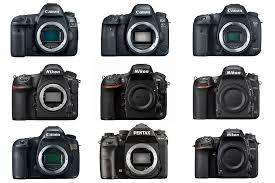
Best budget DSLR cameras for photography enthusiasts
1. Canon EOS 5D Mark IV
Why Choose It?
The Canon EOS 5D Mark IV is an tremendous choice for expert photographers who call for high resolution, surprising low-light performance, and rapid autofocus.
Key Features:
Sensor: 30.4MP Full-Frame CMOS Sensor
Autofocus: Dual Pixel CMOS AF with sixty one-point AF system
ISO Range: 100-32,000 (expandable to 50-102,400)
Burst Shooting: 7 fps
Video: 4K video recording
Connectivity: Built-in Wi-Fi, GPS, NFC
Pros:
✔ High picture resolution and element
✔ Excellent autofocus and occasional-mild overall performance
✔ Great dynamic variety
✔ 4K video functionality
Cons:
✖ Expensive
✖ Heavy body
✖ Crop element in 4K video mode
2. Nikon D850
Why Choose It?
The Nikon D850 is an extremely good all-rounder, offering a excessive-decision sensor, speedy capturing velocity, and brilliant dynamic range, making it best for both landscapes and action photography.
Key Features:
Sensor: forty five.7MP Full-Frame BSI CMOS Sensor
Autofocus: 153-factor AF system
ISO Range: 64-25,six hundred (expandable to 32-102,four hundred)
Burst Shooting: 9 fps
Video: 4K UHD recording at 30 fps
Connectivity: Bluetooth and Wi-Fi
Pros:
✔ Exceptional picture satisfactory and sharpness
✔ Long battery life
✔ Fast and accurate autofocus
✔ High ISO overall performance
Cons:
✖ No built-in flash
✖ Large and heavy
✖ High price tag
3. Canon EOS 90D
Why Choose It?
For those who want a flexible APS-C DSLR with high-pace overall performance, the Canon EOS 90D is a first rate choice, mainly for flora and fauna and sports activities images.
For those who want a flexible APS-C DSLR with high-pace overall performance, the Canon EOS 90D is a first rate choice, mainly for flora and fauna and sports activities images.
Key Features:
Sensor: 32.5MP APS-C CMOS Sensor
Autofocus: 45-factor all-go-type AF machine
ISO Range: one hundred-25,600
Burst Shooting: 10 fps
Video: 4K UHD without crop
Connectivity: Wi-Fi and Bluetooth
Pros:
✔ Excellent decision for an APS-C sensor
✔ Fast and reliable autofocus
✔ Great battery life
✔ Uncropped 4K video recording
Cons:
✖ No in-frame stabilization
✖ Limited dynamic range in comparison to full-frame cameras
four. Nikon D7500
Why Choose It?
The Nikon D7500 is a first-rate mid-range DSLR with superb photo pleasant, proper autofocus, and sturdy battery life, making it ideal for lovers.
Key Features:
Sensor: 20.9MP APS-C CMOS Sensor
Autofocus: fifty one-factor AF system
ISO Range: one hundred-51,2 hundred (expandable to 50-1,640,000)
Burst Shooting: eight fps
Video: 4K UHD at 30 fps
Connectivity: Wi-Fi and Bluetooth
Pros:
✔ Great low-light overall performance
✔ Fast and accurate autofocus
✔ Lightweight for a DSLR
✔ Good battery life
Cons:
✖ Only one SD card slot
✖ No vertical grip choice
five. Canon EOS Rebel T8i (850D)
Why Choose It?
For beginners looking for an affordable but characteristic-packed DSLR, the Canon EOS Rebel T8i is an extremely good entry-stage choice.
Key Features:
Sensor: 24.1MP APS-C CMOS Sensor
Autofocus: 45-factor all-cross-kind AF machine
ISO Range: one hundred-25,600
Burst Shooting: 7 fps
Video: 4K at 24 fps
Connectivity: Wi-Fi and Bluetooth
Pros:
✔ Affordable fee
✔ Easy-to-use controls
✔ Good autofocus for an access-degree DSLR
✔ Vari-attitude touchscreen
Cons:
✖ Limited dynamic range
✖ No in-frame stabilization
✖ Slow burst price in comparison to higher-quit models
6. Pentax K-1 Mark II
Why Choose It?
The Pentax K-1 Mark II is a unique full-frame DSLR that gives climate-sealed construction and built-in stabilization, making it ideal for out of doors photographers.
Key Features:
Sensor: 36.4MP Full-Frame CMOS Sensor
Autofocus: 33-point SAFOX 12 AF system
ISO Range: a hundred-819,2 hundred
Burst Shooting: four.Four fps
Video: Full HD 1080p at 30 fps
Connectivity: Wi-Fi and GPS
Pros:
✔ Excellent build nice with climate sealing
✔ In-body stabilization (uncommon for DSLRs)
✔ High ISO variety for low-mild images
✔ Unique AstroTracer function for night time sky pictures
Cons:
✖ Slower autofocus as compared to competitors
✖ Limited lens selection
✖ Lower video satisfactory than competitors
Choosing the Right DSLR for Your Needs
For Professionals: Canon EOS 5D Mark IV or Nikon D850 are first-rate picks.
For Enthusiasts: Nikon D7500 or Canon EOS 90D gives first rate balance in charge and capabilities.
For Beginners: Canon EOS Rebel T8i is a splendid entry-level digital camera.
For Outdoor and Adventure Photography: Pentax K-1 Mark II with its rugged frame and stabilization is good.
3 notes
·
View notes
Text
I really like my olympus camera but it does suck that it's the only camera from its era that can't accept lenses from any other system even with an adapter. Nikon, Canon, even the high end stuff like Leica and Hasselblad will accept other company's lenses with a cheap adapter but olympus will only take olympus
8 notes
·
View notes
Text
Prothonotary Warbler (Protonotaria citrea)
Spring Bird Migration USA This visit to Maggee Marsh Wildlife Area in Ohio is the first time that I have seen the Prothonotary Warbler. It is quite different from most other Warblers to look at as it does not have a distinctive cap or stripes along the body. Yes it does have a distinctive shade of yellow, as do many warblers. In fact the name is because the plumage represents the yellow of robes…

View On WordPress
#MaggeeMarsh#NikkorZ100400VRS#NikonLove#nikonnofilter#NikonZ9#ProthonotaryWarbler Protonotariacitrea#SpringBirdMigration#ZCreators#(Protonotaris citrea)#Maggee Marsh Wildlife Area#Nikkor Z 100-400mm f/4.5-5.6 VR S#Nikkor Z TC-1.4*#Nikon Camera Systems#Nikon Z 9#OH#Prothonotary Warbler#Richard King Photography#Spring Bird Migration USA#www.mothernatureimages.com#www.richardkingphoto.com
2 notes
·
View notes
Text
Try Our Portrait Photography Lightroom Presets and Fall in Love
Portrait photographers are going to love this! With the Phoblographer’s presets, you can speed up how you work in Lightroom. You folks asked for them, and now you’ve got them! Over the years, the Phoblographer’s staffers have tested various cameras and lenses as well as film emulsions. So we decided to make Lightroom presets that look like the classic film look that you’d see in magazines. In…
#adobe#adobe lightroom#camera#canon#fujifilm#leica#lightroom presets#nikon#olympus#OM SYSTEM#panasonic#portrait photography#portrait presets#raw#sony
0 notes
Note
Do you use film cameras or film apps? What are your recommendations for both.
Both!
These are taken over the course of 2 decades in which I have used probably over 20 different cameras, both film and digital. Even old digital cameras may produce images that resemble film more than newer cameras.
I wouldn't be able to remember all the cameras I've used, especially the old point-and-shoot film/digital ones. I do know I used to use disposable Kodak ones, and those were always fun. I had at least 2 Canon SureShots and PowerShots, and some Nikon Coolpix digital cameras, as well as various Olympus waterproof ones from the 2000s. But I'm pretty sure every film camera I've ever used has been a Canon. Currently, I shoot with a Canon Rebel G from the 90s (with new lenses), and a Canon AE-1 I inherited when my uncle died. (When I was learning film properly it was on borrowed a Pentax K1000 and Nikon F90 at art school, but that wasn't for very long. Only a few weeks.) If I had the money and need, I would buy a Pentax K1000 or KM, if not a Nikon F(N)90. (I'm never going to afford a Leica or anything like that so I don't even think about it. I'd rather spend it on glass.)
For film, I tend to go with Fuji film C200 only because it's much easier to find where I live (and I like it for landscapes better than some others), although I think I prefer the tones of Kodak Gold (or Portra 400/800) better (for people and urban environments). I'd say Ektar overall but again, where I am, it can be harder to source. And I've used Kodak Ultra Max 400 for like, friends and parties and stuff.
Just depends what I can get my hands on and what I will be shooting.
So, the film matters as much as the camera sometimes. As do lenses. As can your choice of flash (for low light). As can the scanner. Unless you have an incredibly excellent scanner, the photos are always gonna have a more rustic sort of blurry look. (Like mine. I had a decent scanner and still it was not true to life. The built-in scanner I have on my printer now is absolute shit for photos.)
I don't really have a recommendation as they're all sort of different cameras. It really depends how much you want to think and work to compose a shot. (The Rebel G is more beginner-friendly and can be used as a point-and-shoot. And since it's all plastic, it's super light. My workhorse lens is actually heavier than the camera lol.)
For my digital photos, which are a pretty significant number of photos I have posted so far (I don't have a good scanner anymore so I have a backlog of film...), they are all sorts of resolutions and lenses and cameras, some of which don't require any film "apps" to look more vintage.
I'm sorry I don't actually know what you mean by film apps. Like filters? It's not something I'm particularly familiar with. I work in Lightroom. But I wouldn't consider it a film app. (I don't use any phone apps. My only processing is done in Lightroom, usually on my laptop.)
If you mean presets, then yes, I do use those when posting photos here. (Mostly because I know what photo theft is like online, and I'd prefer not to post originals in full quality, which I do make some income from. And for the aesthetic, sometimes.)
The presets I use are my own. There's nowhere I can point you to to download the same ones I use. I have a whole library of my own presets for all sorts of photos I've designed over the years. I'll say the ones I use here usually involve a hell of a lot of grain added, lol. Decreased clarity and texture. Contrast can either be turned up or down, it depends on the original photo. I mean... since I used so many cameras and the photos are in such varying quality and resos, I don't have a set rubric for all. I adjust as I need to get a slightly consistent look. The older the photos, the more grain seems to ruin them.
I love Nikon for digital. It's my go to. I started with Olympus (E-500) but their 4/3rds system was just irritating when it came to upgrading and lenses. I won't say I didn't like Oly, I truly did. But in terms of growth, it was too limiting and the glass was just too expensive for me. I switched to Nikon and never looked back. Mostly because I prefered how Nikon bodies felt in my hands vs. the Canon ones.
I fully recommend any of the Nikon D7000 series for novices, but especially the D7200 as an intermediate camera is still a solid choice even now, and performs really well dynamically. Unless you want to get into full frame and high end print photography, you don't need to go the FX route.
I sometimes still take my old D7200 travelling since it is smaller and I kept most of my DX lenses. It's affordable and the quality is pretty good, and if you're putting your photos through presets anyway, the lack of sharpness or whatever issues you may have will be negligible. I currently use a D850, but I have shot D750, D3, and D5 for professional gigs. I'd love a D5 myself but I'm not making enough money to justify it.
I also have a Fuji X-T100 (mirrorless) but I'm gonna be honest, I don't love it. I find it finnicky, annoying interface, exposure is weird, don't like the colour tones, and lacks some je ne sais quoi that my Nikons have. I bought it to make travel photography easier and find I spend more time deleting all the shitty photos I took rather than being happy with the results. Allegedly, according to like everybody else, it's a great camera. So, tbh, I think it's me. I think I'm the problem. I think I'm also just biased and too stubborn to learn a new system. Nikon is like second-nature to me, any Nikon camera and I can just use it. But Fuji? Idk.
I prefer always to shoot full manual, but I get annoyed with my XT100 since it's all different and I am always forgetting the different menus and button combos to do what I want.
It also has no Lightroom integration for their raw files. (Or at least at the last update I did, they didn't.)
If you want the more vintage look, grabbing a cheap digital camera from the 2000s will accomplish a lot of that. There's a whole subculture now around 00s digital camera photography. And it will often mimic film slightly better because new digital cameras are really "smart", especially phone cameras which basically remove all control from you and automatically apply HDR or what have you. It's very difficult to genuinely mimic film with modern phone and digital cameras due to great sensors (CMOS) and (in camera) processing.
Note: CCD sensors do NOT give you "film-like" photos, no matter what. It's still digital. Really the old P&S digicams are great to remove all the "intelligent" features of new cameras. And when you use on-camera flash, it's like being thrown into the indie sleaze pool immediately lol. I will say, and without doing extensive research, but the moajority of photos you see posted online that say "film" or "i shoot film" are not actually film. They're digital with filters or LR presets applied to give a film look. There are probably 100s of designers of "film presets" to mimic all sorts of film. I tried a few but found they never really worked for me.
I know a lot of people have issues with Adobe Lightroom cos of their new TOS and subscription model, but at this point, I still haven't found a program that works as well for fast, stream-lined processing. (I used to use programs like Corel PSP, but Adobe is so much more powerful. I still have PSP, but rarely use it anymore.)
I don't know if any of this helps! I hope it answered some questions you may have had.
2 notes
·
View notes
Text
First Film Camera Quick Guide!
I was putting together a list for a partner who's been interested in buying a film camera that can do a little more than his point and shoot and it was recommended to me that I share the picks I sent him!
This is by no means comprehensive but these are the four that come to mind for me. I've kept the options $200 and below (with lens, based on ebay listings) with the idea being if this is your first film camera, or first film SLR, you probably don't want to spend much more than that.
For anyone who's been shooting for a while who has some other options to share please feel free to mention them so nothing gets overlooked!
Nikon F4 ($200)
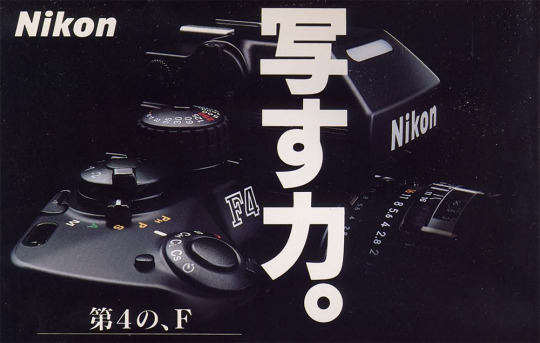
Pros: It was Nikon's first professional auto focus camera and also has multiple auto exposure modes from full auto, to aperture and shutter speed priority! It has great build quality, Nikons are known to be indestructible. It has advanced metering to help make sure everything in the frame is exposed properly. The F mount has been around for 70 years and counting and has the largest library of lenses available, many of which are fairly inexpensive. It also has the best viewfinder on this list for glasses wearers due to its size!
Cons: It's a tank! It's big and chunky and much like many other auto focus film cameras of the era it has that ugly DSLR look. It has a Swiss army knife worth of features many of which you may never use!
Canon EOS Rebel GII (>$100)
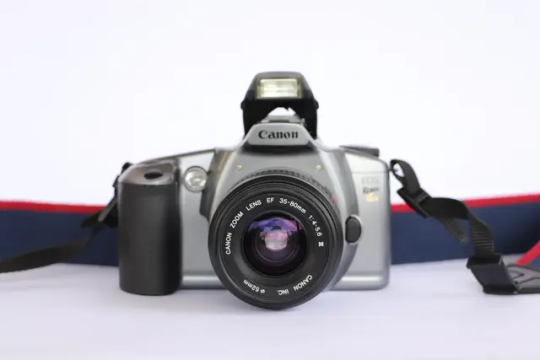
Pros: You can get the body and a lens for under $100 making it the cheapest option on this list! It's capable of auto focus and a number of different exposure modes that let you learn various settings or take pictures with the ease of a point and shoot. The EOS mount lasted for 30+ years so there's a wide variety of lenses across a wide spectrum of prices.
Cons: It's an enthusiast grade camera with consumer grade build quality and a somewhat limited feature set for a late era film SLR --but all the right features are included. It's big, chunky, kinda ugly.
Olympus OM-2 ($150)
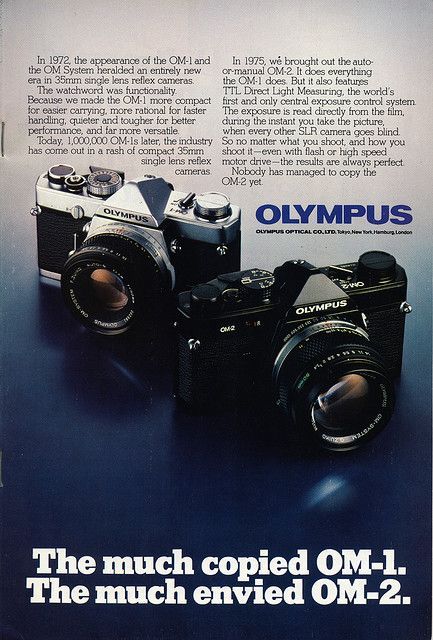
Pros: It's really small for a professional camera! It has that classic film SLR look, and it was in FLCL! It's manual focus, but does have some auto exposure tools to assist you. You'll have to dial in aperture to your liking but shutter speed can be determined for you. You can grab one of these with a lens for around $150.
Cons: It will have a steeper learning curve than the auto focus cameras on this list. The OM mount library is pretty limited and while the 50mm lens you probably get with it will be cheap most other focal lengths get a little more pricey due to availability.
Nikon FE ($200)
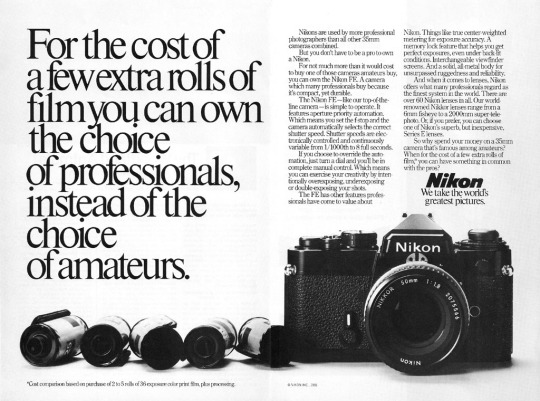
Pros: Another small manual focus camera with auto exposure features! It uses the F mount so it's an easy system camera to grow into if you think you'll want to experiment with different focal lengths along the way! It's a Nikon so it'll probably outlast us all.
Cons: It's pricier up front than the OM-2 and if you don't think you'll want to experiment with different focal lengths down the line it probably isn't worth it!
Point & Shoot!
If you're looking for a point and shoot my main recommendation is to buy anything that's $50 or less. They all more or less work the same and they're all ticking time bombs of 90s consumer electronic goodness.
Facebook market place is a sadly a great place to find them, and where I got my beloved little Olympus MJU for $20 three years back!
Final Frame
Like I said up top, none of this is definitive! If you find something you think you can grow into that gets you excited to get out and shoot that's the camera for you! The most important thing is to have fun and make some art! Enjoy <3
#35mm film#photography#film photography#cameras#film cameras#camera gear#buyers guide#nikon f4#canon eos rebel gii#olympus om2#nikon fe#point and shoot cameras#film slr
3 notes
·
View notes
Text





The Nikon F3AF of 1983 – an early, fascinating, ultimately unsuccessful attempt at practical autofocus in a stills camera.
Based on a standard F3 body, it added electrical contacts for two dedicated AF lenses, and a removable, separately-powered DX-1 head, which provided through-the-lens (TTL) autofocus. Focusing elements in the lens are moved by motors built inside the lenses themselves – a concept that is now standard in modern SLR and mirrorless systems.
Basically, take a Nikon F3 and an AT-AT Imperial Walker, smash them together, and you have the F3AF.
8 notes
·
View notes
Text

Windy City of Lights
At night, the Windy City transforms into a city of lights, illuminated by the orange and white hues of the Chicago Metropolitan Area. In this nighttime photo, taken by an astronaut aboard the International Space Station, light-yellow lights illuminate the city’s densely populated downtown area.
The Chicago Harbor and Navy Pier in downtown Chicago extend into Lake Michigan. Warm-hued lights illuminate sprawling roadways like Interstate 90, which stands out as the wide, orange line. The range of colors in nighttime cityscapes worldwide, including Chicago, is often due to the types of lighting used. High-pressure sodium lighting has a much warmer tone than the cooler, blue-to-green-hued light-emitting diodes (LEDs).
Flowing through the city, the Chicago River appears as a slender strip of darkness, running nearly parallel to interstates 55 and 90. The Chicago River connects Lake Michigan barge traffic to neighboring rivers, such as the Des Plaines River, through tributaries and various canal systems. The Des Plaines River appears as a dark feature between the metropolitan area and Chicago O’Hare International Airport. This river is lined with nature preserves, golf courses, and parks, all of which appear dark in this nighttime image. In urban landscapes, city lights outline dark and open areas like the Rosehill Cemetery and Big Marsh Park.
As Chicago expanded in the late 1800s, the city needed a solution to simplify navigation. The city was reorganized into a grid layout, restructuring street names, address numbers, and blocks into north-south and east-west orientations. This grid pattern is made obvious by the nighttime lights of the urban area. The warm-toned lights associated with residential areas contrast with the predominantly white lighting of commercial, industrial, and transportation areas. These land uses typically line highways and are spread across the outskirts of the Chicago area.
Astronaut photograph ISS070-E-105097 was acquired on March 1, 2024, with a Nikon D5 digital camera using a focal length of 400 millimeters. It is provided by the ISS Crew Earth Observations Facility and the Earth Science and Remote Sensing Unit, Johnson Space Center. The image was taken by a member of the Expedition 70 crew. The image has been cropped and enhanced to improve contrast, and lens artifacts have been removed. The International Space Station Program supports the laboratory as part of the ISS National Lab to help astronauts take pictures of Earth that will be of the greatest value to scientists and the public, and to make those images freely available on the Internet. Additional images taken by astronauts and cosmonauts can be viewed at the NASA/JSC Gateway to Astronaut Photography of Earth. Caption by Sara Schmidt, GeoControl Systems, JETS II Contract at NASA-JSC.
7 notes
·
View notes